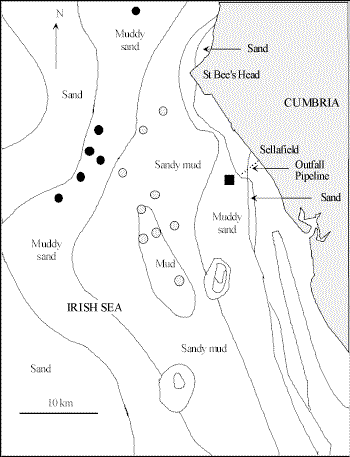Case study: the north-eastern Irish Sea
Distribution of sediment types in the north-eastern Irish
Sea near Sellafield, Cumbria.
There have been very few surveys of the distribution of biotopes within
this complex over large areas of sea floor with a gradient of sediment types. The most
detailed is that of Hughes & Atkinson (1997), who used towed underwater video to plot
the distribution of megafaunal burrowers in the north-eastern Irish Sea off the Cumbrian
coast. Visual estimates of population densities were supplemented by data from box-core
samples. Sediments were distributed in broad bands running roughly parallel to the
coastline (see figure below), extending from an offshore muddy sand (10 - 30% silt-clay
content) onto progressively finer muds (up to 75 - 85% silt-clay), before coarsening again
close inshore (muddy sand, 20 - 30% silt-clay, underlain by a layer of shell gravel). The
sea floor was heavily burrowed by megafauna, but community composition changed markedly
over the gradient of sediment types. The offshore muddy sand was dominated by Callianassa
subterranea (estimated density 88 individuals m-2), occupying multi-opening
burrows of the type previously described from the North Sea (Witbaard & Duineveld,
1989; Rowden & Jones, 1995). The large thalassinoidean Upogebia deltaura was
also common (estimated 22 individuals m-2). The crab Goneplax rhomboides
was present at low density. No sea pens were seen here.
The central finer muds supported a more diverse megafaunal community,
with sea floor topography dominated by burrow openings of Nephrops norvegicus and
the large ejecta mounds of Maxmuelleria lankesteri. The visual survey gave an
estimate of 0.6 - 1.3 Nephrops burrow systems m-2, while box-core
samples indicated a density of up to 10 Maxmuelleria individuals m-2.
The burrowing community also included Callianassa subterranea, Calocaris
macandreae, Jaxea nocturna and Goneplax rhomboides. The sea pen Virgularia
mirabilis was present but rare.
The inshore muddy sand had a much lower burrow density than the other
two zones, with no large ejecta mounds or Nephrops burrows. The most common
burrower was again Callianassa subterranea (estimated 23 individuals m-2),
with Upogebia deltaura present at much lower density. Goneplax rhomboides was
fairly common (estimated 2 individuals m-2). Virgularia mirabilis also
occurred most commonly in this biotope (10 individuals m-2). Although its
characteristic ‘volcano’ mounds were not seen on the video recordings,
box-coring showed that Maxmuelleria lankesteri was also sparsely present in this
relatively coarse sediment.
The sediment characteristics and faunal composition of the biotopes
observed are summarised in the table below. An assessment of their position in the MNCR
biotope classification is also given.
|
Offshore muddy sand |
Central mud/sandy mud |
Inshore muddy sand |
Sampling location* |
54o 25.07’N
03o 50.22’W |
54o 19.83’N
03o 41.64’W |
54o 24.00’N
03o 33.30’W |
Depth (m) |
~30 |
~35 |
~20 |
% Silt-clay |
~20 |
~85 |
~25 |
Major megafaunal burrowers |
Callianassa subterranea Upogebia deltaura |
Maxmuelleria lankesteri, Nephrops norvegicus |
C. subterranea U. deltaura
G. rhomboides |
Other megafaunal burrowers present |
Goneplax rhomboides |
C. subterranea Calocaris macandreae
Jaxea nocturna
G. rhomboides |
M. lankesteri |
Virgularia mirabilis |
Absent |
Rare |
Common |
MNCR Biotope code |
Most similar to CMS.AfilEcor |
CMU.SpMeg |
Most similar to CMS.VirOph |
* The locations of each station sampled by box-coring in June 1995 are
given. These stations corresponded closely with areas surveyed by towed camera in
September 1993.
A significant finding, obtained by comparing the results of towed
camera and box-core surveys in the same area, was that visual estimates of megafaunal
densities (derived from counts of burrow openings) consistently underestimated the number
of animals present in the sediment. This issue will be discussed further in the section
dealing with monitoring and surveillance options (Chapter VII).
Distribution of sediment types in the north-eastern
Irish Sea near Sellafield, Cumbria.
Solid black circles: Offshore muddy sand with Callianassa
subterranea and Upogebia deltaura. Solid grey circles: Central mud/sandy mud
with Maxmuelleria lankesteri, Nephrops norvegicus and other burrowing megafauna.
Solid square: Inshore muddy sand with Virgularia mirabilis, Callianassa subterranea and
Upogebia deltaura.

Next Section
References
|

